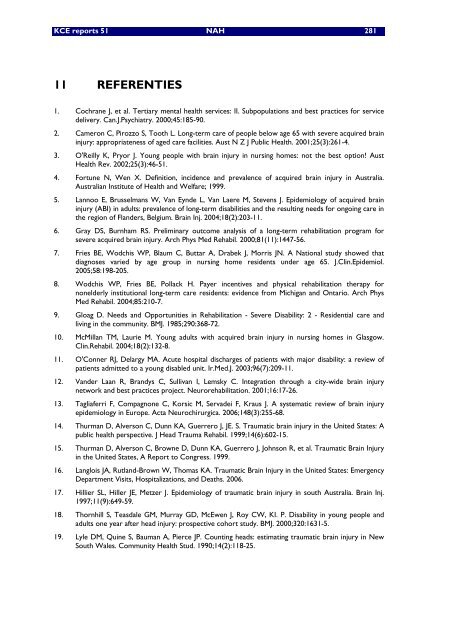Chronische zorgbehoeften bij personen met een NAH - KCE
Chronische zorgbehoeften bij personen met een NAH - KCE
Chronische zorgbehoeften bij personen met een NAH - KCE
You also want an ePaper? Increase the reach of your titles
YUMPU automatically turns print PDFs into web optimized ePapers that Google loves.
<strong>KCE</strong> reports 51 <strong>NAH</strong> 281<br />
11 REFERENTIES<br />
1. Cochrane J, et al. Tertiary mental health services: II. Subpopulations and best practices for service<br />
delivery. Can.J.Psychiatry. 2000;45:185-90.<br />
2. Cameron C, Pirozzo S, Tooth L. Long-term care of people below age 65 with severe acquired brain<br />
injury: appropriateness of aged care facilities. Aust N Z J Public Health. 2001;25(3):261-4.<br />
3. O'Reilly K, Pryor J. Young people with brain injury in nursing homes: not the best option! Aust<br />
Health Rev. 2002;25(3):46-51.<br />
4. Fortune N, Wen X. Definition, incidence and prevalence of acquired brain injury in Australia.<br />
Australian Institute of Health and Welfare; 1999.<br />
5. Lannoo E, Brusselmans W, Van Eynde L, Van Laere M, Stevens J. Epidemiology of acquired brain<br />
injury (ABI) in adults: prevalence of long-term disabilities and the resulting needs for ongoing care in<br />
the region of Flanders, Belgium. Brain Inj. 2004;18(2):203-11.<br />
6. Gray DS, Burnham RS. Preliminary outcome analysis of a long-term rehabilitation program for<br />
severe acquired brain injury. Arch Phys Med Rehabil. 2000;81(11):1447-56.<br />
7. Fries BE, Wodchis WP, Blaum C, Buttar A, Drabek J, Morris JN. A National study showed that<br />
diagnoses varied by age group in nursing home residents under age 65. J.Clin.Epidemiol.<br />
2005;58:198-205.<br />
8. Wodchis WP, Fries BE, Pollack H. Payer incentives and physical rehabilitation therapy for<br />
nonelderly institutional long-term care residents: evidence from Michigan and Ontario. Arch Phys<br />
Med Rehabil. 2004;85:210-7.<br />
9. Gloag D. Needs and Opportunities in Rehabilitation - Severe Disability: 2 - Residential care and<br />
living in the community. BMJ. 1985;290:368-72.<br />
10. McMillan TM, Laurie M. Young adults with acquired brain injury in nursing homes in Glasgow.<br />
Clin.Rehabil. 2004;18(2):132-8.<br />
11. O'Conner RJ, Delargy MA. Acute hospital discharges of patients with major disability: a review of<br />
patients admitted to a young disabled unit. Ir.Med.J. 2003;96(7):209-11.<br />
12. Vander Laan R, Brandys C, Sullivan I, Lemsky C. Integration through a city-wide brain injury<br />
network and best practices project. Neurorehabilitation. 2001;16:17-26.<br />
13. Tagliaferri F, Compagnone C, Korsic M, Servadei F, Kraus J. A systematic review of brain injury<br />
epidemiology in Europe. Acta Neurochirurgica. 2006;148(3):255-68.<br />
14. Thurman D, Alverson C, Dunn KA, Guerrero J, JE. S. Traumatic brain injury in the United States: A<br />
public health perspective. J Head Trauma Rehabil. 1999;14(6):602-15.<br />
15. Thurman D, Alverson C, Browne D, Dunn KA, Guerrero J, Johnson R, et al. Traumatic Brain Injury<br />
in the United States, A Report to Congress. 1999.<br />
16. Langlois JA, Rutland-Brown W, Thomas KA. Traumatic Brain Injury in the United States: Emergency<br />
Department Visits, Hospitalizations, and Deaths. 2006.<br />
17. Hillier SL, Hiller JE, Metzer J. Epidemiology of traumatic brain injury in south Australia. Brain Inj.<br />
1997;11(9):649-59.<br />
18. Thornhill S, Teasdale GM, Murray GD, McEwen J, Roy CW, KI. P. Disability in young people and<br />
adults one year after head injury: prospective cohort study. BMJ. 2000;320:1631-5.<br />
19. Lyle DM, Quine S, Bauman A, Pierce JP. Counting heads: estimating traumatic brain injury in New<br />
South Wales. Community Health Stud. 1990;14(2):118-25.

















